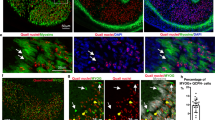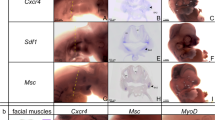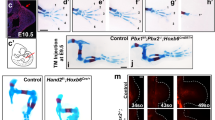Abstract
During vertebrate embryogenesis, myogenic precursor cells of limb muscles delaminate from the ventro-lateral edge of the somitic dermomyotome and migrate to the limb buds, where they congregate into dorsal and ventral muscle masses1,2. It has been proposed that the surrounding connective tissue controls muscle pattern formation in limbs3,4,5. Regulatory molecules such as receptor tyrosine kinases like c-Met ( ref. 6) and those encoded by homeobox-containing genes, including c-Met (ref. 6), Tbx1 ( ref. 7), Mox2 (ref. 8), Six1 and Six2 (ref. 9), Pitx2, Pax3 (refs 10,11) and Lbx1h (refs 12,13), are expressed in migrating limb precursor cells. The role of these genes in the patterning of limb muscles is unknown, although mutation of Pax3 or Met causes disruption of limb muscle development at an initial step, disturbing the epithelial-to-mesenchymal transition of the somitic epithelium6,10,11. No limb muscle cells form in these mutants, and the early loss of myogenic precursor cells prevented an analysis of later functions of these genes during limb muscle development14. Based on quail-chick chimaera studies3,15, it was assumed that a cell-autonomous contribution of myogenic cells to the formation of individual limb muscles is negligible, and that an instructive role of limb mesenchyme is critical in this process. Here we show that Lbx1h determines migratory routes of muscle precursor cells in a cell-autonomous manner, thereby leading to the formation of distinct limb muscle patterns. Inactivation of Lbx1h, which is specifically expressed in migrating muscle precursor cells12,13, led to a lack of extensor muscles in forelimbs and an absence of muscles in hindlimbs. The defect was caused by the failure of all muscle precursor cells of hindlimbs and of precursor cells of extensor muscles of forelimbs to migrate to their corresponding muscle anlagen. Our results demonstrate that Lbx1h is a key regulator of muscle precursor cell migration and is required for the acquisition of dorsal identities of forelimb muscles.
This is a preview of subscription content, access via your institution
Access options
Subscribe to this journal
Receive 12 print issues and online access
$209.00 per year
only $17.42 per issue
Buy this article
- Purchase on Springer Link
- Instant access to full article PDF
Prices may be subject to local taxes which are calculated during checkout




Similar content being viewed by others
References
Christ, B., Jacob, H.J. & Jacob, M. Experimental analysis of the origin of the wing musculature in avian embryos. Anat. Embryol. (Berl) 150, 171–186 (1977).
Martin, P. Tissue patterning in the developing mouse limb. Int. J. Dev. Biol. 34, 323–336 ( 1990).
Chevallier, A. & Kieny, M. On the role of the connective tissue in the patterning of the chick limb musculature. Wilhelm Roux's Arch. Dev. Biol. 191, 277–280 (1982).
Mauger, A., Kieny, M., Hedayat, I. & Goetinck, P.F. Tissue interactions in the organization and maintenance of the muscle pattern in the chick limb. J. Embryol. Exp. Morphol. 76, 199– 215 (1983).
Brand-Saberi, B., Wilting, J., Ebensperger, C. & Christ, B. The formation of somite compartments in the avian embryo. Int. J. Dev. Biol. 40, 411–420 (1996).
Bladt, F., Riethmacher, D., Isenmann, S., Aguzzi, A. & Birchmeier, C. Essential role for the c-Met receptor in the migration of myogenic precursor cells into the limb bud. Nature 376, 768–771 ( 1995).
Isaac, A. et al. Tbx genes and limb identity in chick embryo development. Development 125, 1867–1875 (1998).
Candia, A.F. & Wright, C.V. Differential localization of Mox-1 and Mox-2 proteins indicates distinct roles during development. Int. J. Dev. Biol. 40, 1179–1184 (1996).
Oliver, G. et al. Homeobox genes and connective tissue patterning. Development 121, 693–705 (1995).
Bober, E., Franz, T., Arnold, H.-H., Gruss, P. & Tremblay, P. Pax-3 is required for the development of limb muscles: a possible role for the migration of dermomyotomal muscle progenitor cells. Development 120, 603–612 (1994).
Goulding, M., Lumsden, A. & Paquette, A.J. Regulation of Pax-3 expression in the dermomyotome and its role in muscle development. Development 120 , 957–971 (1994).
Jagla, K. et al. Mouse Lbx1 and human LBX1 define a novel mammalian homeobox gene family related to the Drosophila lady bird genes. Mech. Dev. 53, 345–356 ( 1995).
Mennerich, D., Schafer, K. & Braun, T. Pax-3 is necessary but not sufficient for lbx1 expression in myogenic precursor cells of the limb. Mech. Dev. 73, 147–158 (1998).
Daston, G., Lamar, E., Olivier, M. & Goulding, M. Pax-3 is necessary for migration but not differentiation of limb muscle precursors in the mouse. Development 122, 1017– 1027 (1996).
Butler, J., Cosmos, E. & Cauwenbergs, P.C. Positional signals: evidence for a possible role in muscle fibre-type patterning of the embryonic avian limb. Development 102, 763–772 ( 1988).
Tajbakhsh, S., Rocancourt, D. & Buckingham, M. Muscle progenitor cells failing to respond to positional cues adopt non-myogenic fates in myf-5 null mice. Nature 384, 266–270 (1996).
Sassoon, D. et al. Expression of two myogenic regulatory factors myogenin and MyoD1 during mouse embryogenesis. Nature 341, 303–307 (1989).
Braun, T., Rudnicki, M.A., Arnold, H.-H. & Jaenisch, R. Targeted inactivation of the muscle regulatory gene myf-5 results in abnormal rib development and perinatal death. Cell 71, 369–382 (1992).
Bancroft, J.D. & Stevens, A. Theory and Practice of Histological Techniques (Churchill Livingston, Edinburgh, 1990).
Floss, T., Arnold, H.-H. & Braun, T. A role for FGF-6 in skeletal muscle regeneration. Genes Dev. 11, 2040–2052 (1997).
Zweigerdt, R., Braun, T. & Arnold, H.-H. Faithful expression of the Myf-5 gene during mouse myogenesis requires distant control regions: a transgene approach using yeast artificial chromosomes. Dev. Biol. 192, 172– 180 (1997).
Acknowledgements
We thank E. Bober and R. Schnabel for reading the manuscript; R. Jaenisch for the genomic phage library; R. Faessler for pWH9; and H.-H. Arnold for support and encouragement during the initial phase of the project. This work was supported by the SFB 271: Molekulare Mechanismen Morphoregulatorischer Prozesse DFG Grant Br1413/4–1 to T.B., Fonds der Chemischen Industrie and the Boehringer Ingelheim Fonds für Medizinische Grundlagenforschung.
Author information
Authors and Affiliations
Corresponding author
Rights and permissions
About this article
Cite this article
Schäfer, K., Braun, T. Early specification of limb muscle precursor cells by the homeobox gene Lbx1h. Nat Genet 23, 213–216 (1999). https://doi.org/10.1038/13843
Received:
Accepted:
Issue Date:
DOI: https://doi.org/10.1038/13843
This article is cited by
-
Embryonic muscle splitting patterns reveal homologies of amniote forelimb muscles
Nature Ecology & Evolution (2022)
-
Genetic and serum markers in adult degenerative scoliosis: a literature review
Spine Deformity (2022)
-
Master regulators of skeletal muscle lineage development and pluripotent stem cells differentiation
Cell Regeneration (2021)
-
Primary myogenesis in the sand lizard (Lacerta agilis) limb bud
Development Genes and Evolution (2019)
-
Stepwise participation of HGF/MET signaling in the development of migratory muscle precursors during vertebrate evolution
Zoological Letters (2018)



